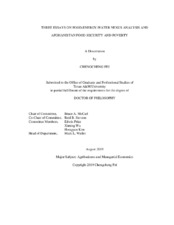| dc.description.abstract | Food Energy Water (FEW) Nexus is studied under water scarcity examine the economics of resource allocation and decision making among competing FEW users under the assumption that coordinated decision making would increase regional social welfare and improve the sustainability of environment and resources. Population growth and climate change are considered as they can stress a currently working water scarce Nexus system as it evolves into the future. The work is presented in three essays. The first two essays focus on a Nexus case study in South Central Texas where water scarcity is a key concern. Furthermore, the region is projected to exhibit a drier climate and doubled population, which will further exacerbate water scarcity. In order to mitigate this water scarcity problem, the Texas Water Development Board (TWDB) regional planning group has proposed a number of water projects. This work examines possible FEW Nexus actions in this region to see whether coordinated action can improve regional social welfare. To do this we employed an integrated model EDSIMRGW_NEX, which simulates regional agricultural and electricity production as well as water allocation between agriculture, cooling, fracking and M&I. We used that model to examine the impacts of population growth and climate change on agriculture, water project construction and water project operation decisions. We found that the drier future climate has negative effects on the agriculture sector, while population growth has little impact on agriculture. More water projects are constructed and operated with population growth and climate change. We find climate change affects the selection and pace of water projects construction and operation. Food security and poverty in Afghanistan is addressed in the third essay. In Afghanistan, food security is a severe problem, with about 36% of the households classified as food insecure.
Poverty is also common in Afghanistan. According to the NRVA 2011 survey data, more than 80% of households fall under the global poverty line. In examining the situation we considered whether road blockages exacerbate poverty and food insecurity We find that road blockages have negative impacts on food security, nutrition balance, household income and coping strategies selection, but less impact on total calories intake. Road blockages also increased the proportion of households in poverty. | en |


